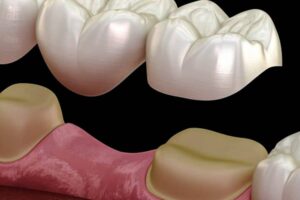Crowns (Caps)
A crown (also known as a cap) is a covering that completely encases the tooth surface, returning it to its initial size and shape. When tooth structure cannot be repaired with fillings or other types of restorations, a crown protects and fortifies it. There are many different kinds of crowns, but porcelain (tooth-coloured crowns) are the most common since they look the most like your real teeth.
Although they are very strong and will survive for many years, they might eventually need to be replaced, just like the majority of dental restorations.
Porcelain crowns are created to match the size, shape, and colour of your teeth, giving you a beautiful smile that looks natural and lasts a long time.
Reasons for crowns:
- Cracked or broken teeth
- Cosmetic enhancement
- Teeth are decayed
- Fractured fillings
- Large fillings
- Teeth with root canal
What happens when you get a crown?
Two appointments are typically needed for a crown operation. Several extremely precise molds (or impressions) will be taken during your initial session in order to manufacture your personalized crown. Additionally, a temporary crown will be made from a mold and placed on your tooth for roughly two weeks while a dental lab fabricates your new crown.
The dentist will prepare the tooth by removing any decay and contouring the surface to suit the crown while the tooth is numb. After completing these steps, your temporary crown will be affixed to your teeth with temporary cement, and your bite will be examined to make sure you are biting correctly.
Your temporary crown will be removed, the tooth will be cleaned, and your new crown will be meticulously positioned to ensure proper spacing and bite at your second appointment.
You will be given maintenance instructions and urged to check your new crown at frequent dental checkups.






